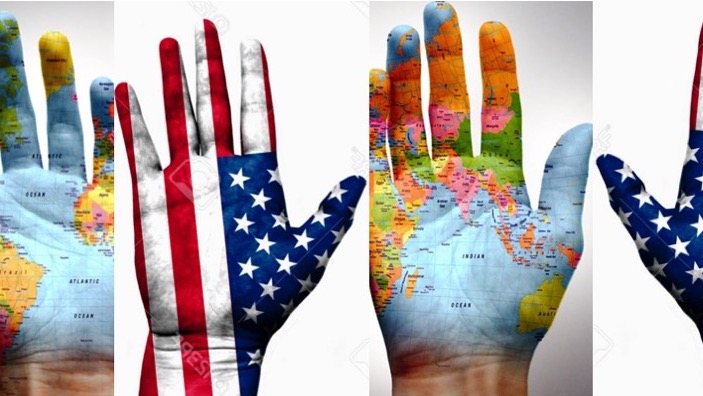Annelies Kusters, 12 September 2019
Note: this blog is based on a longer article: “The tipping point: On the use of American Sign Language in International Sign” Language & Communication 75 – open access here: https://doi.org/10.1016/j.langcom.2020.06.004
“There is a lot of ASL in International Sign”, and “That does not look like International Sign to me, but rather ASL”, are some commonly and frequently uttered phrases in a subset of international deaf gatherings. When the use of American Sign Language (ASL) in International Sign (IS) is discussed, people often spontaneously estimate (and disagree on) percentages of ASL in IS, eg “half of it”, 30%, 60%, 40%, 70%, 80%. They also offer terms to describe forms of IS that have a lot of ASL in it, or language use that is not recognized as IS, but neither as the “American way of ASL”. Such terms or descriptions included “International ASL (IASL)”, “strong ASL [in IS]”, “IS with ASL flavor”, “ASL light”, “ASL with neutral/unmarked handshapes”, “world ASL”, “global ASL”, “(West-)European ASL” and “bad ASL”. (Note that these labels do not necessarily refer to the same usages or amounts of ASL in IS.)
As a part of the MobileDeaf project, I study language ideologies on IS in a range of different contexts. In this blog I report discourses on IS, recorded in research in 2017 and 2018, in contexts where interpreter services (to and from IS and other sign languages/spoken languages) were not provided, more particularly the Deaf Academics conferences; the SIGN8 conference in Florianopolis, Brazil; the Frontrunners course in Denmark; and three IS courses. In these contexts I organised 6 focus groups and 30 interviews with participants and presenters, students and teachers. Most of them are internationally mobile deaf students, advocates, professionals and researchers from Europe, North-America and South-America, with a few exceptions. Many of them were people with the experience of participating in international deaf networks in Europe. Note that the “anti-ASL” discourses below were recorded in these specific contexts and cannot be generalized beyond them. Indeed, in other cases within my study I encountered very different (more pragmatic and accepting) views on the use of ASL in international deaf communication, and will report upon them in further blogs.
What are ASL and IS?
ASL is a national sign language that emerged in the US in the 19thcentury, and since then, it has dispersed all over the world, in different contexts and through different means. First, missionaries, educationists and development workers introduced it into a significant number of countries in Africa, Asia and South America, reportedly from the 1950s onwards. Some sign languages include a high proportion of ASL(-based) lexicon because of the introduction of ASL in emergent educational systems. In many countries, sign languages influenced by ASL have been given a national name (eg. Ghanaian Sign Language, Thai Sign Language, Filipino Sign Language). The use of ASL or ASL-influenced sign languages is often connected to the reduced use, prestige and status of other national or local sign languages and is sometimes resisted, such as in the form of language purification projects.
Another important factor in the spread of ASL are deaf and hearing non-American students who study at American universities such as Gallaudet University (a bilingual ASL-English university), where they become fluent in ASL, which they then bring back to their country. ASL resources and learning material are widely available online, particularly on Youtube and social media, such as TV series, films, vlogs and signed songs in ASL, as well as ASL comedy skits. The availability of a broad range of resources in ASL and exposure to ASL have resulted in an increasing number of ASL signs being included in national sign languages and in IS, sometimes to fill perceived or experienced lexical gaps. People also pick up ASL through interactions with foreigners, such as ASL-using visitors to their country, or intentionally acquire (some) ASL before engaging in international encounters. ASL (like IS) is often used as an intermediary language when foreign visitors learn the local sign language. Because of its global use, a number of deaf leaders and activists, and scholars such as sign linguists and Deaf Studies scholars have labeled ASL as imperialist, colonialist, or a “killer language”.
International Sign takes place when signers of different linguistic backgrounds come together. An important ideology underlying IS use is that it is (or should be) more iconic and transparent and therefore easier to learn and understand than national sign languages such as ASL. IS typically incorporates signs from national sign languages (including ASL) and often includes mouthings from different spoken languages (but mostly English). Its use is variable and dependent on the geographical, political, social, cultural and linguistic context in which it occurs and the backgrounds of the people who use it. I approach IS as a translingual practice: deaf people who engage in IS are translanguaging, a term that has been coined to frame the intermingled use of diverse linguistic resources. Willingness of the interlocutor to communicate flexibly is crucial in translingual practices.
How do people use ASL in IS?
Since people draw from their individual language knowledge in IS, and since ASL is a widely spread resource, it is not surprising people draw upon ASL when they sign in IS. This has inevitably led to usages of IS in which a lot of ASL signs and grammatical structures are in use. (Note that it is often hard to judge whether a way of signing is ASL or not, as I explain further below.)
So, why and in what contexts do people make use of ASL signs in IS?
- Some ASL Signs have long been a part of the core lexicon of IS (ie: IMPORTANT, WHY)
- When people sign IS they may be inclined towards trying to eliminate their national signs from their IS. Sometimes that might mean ASL becomes an alternative resource.
- ASL is a sign language with a large number of signs and and in combination with its worldwide use, people may feel this allows them to easily insert specific political, technical or academic terms in IS. This does not mean that is generally impossible to be specific in IS, but that it is often experienced as being more time-consuming to be specific in IS, because of the time it takes to explain or paraphrase concepts. The aim of specificity also could be reached by including lexical signs from other sign languages than ASL, however, many participants found it more time-consuming to exchange, learn and circulate signs that are not yet widely known.
- People may feel it is acceptable or even preferable to use ASL lexicon in IS because they connect it to higher level discourse(perhaps partially because people associate ASL with a broad lexicon and/or with Gallaudet university).
- People may connect ASL to being worldwise and with cosmopolitanism.
- People may find particular ASL signs beautifuland therefore use them.
Why do some people think ASL use in IS is a problem?
When participants felt too much ASL was used in IS, they said it was disrespectful, oppressive and/or simply out of place in contexts where people expected to see IS used, such as international conferences or workshops, for a number of reasons:
- A key objection of participants against use of (too much) ASL in IS, is that they saw ASL as a “killer language” and therefore argued that ASL should not be embraced uncritically, wholesale or indiscriminately in contexts of International Sign use.
- A number of participants in my study viewed the use of “too much ASL in IS” as counterproductive, crowding out space for IS to thrive and flourish. In other words, research participants felt that when IS looks too much like ASL, it is not IS.
- Another key argument against ASL use in IS is related to understanding. Some ASL signs (such as “MOTHER” and “IMPORTANT”) are widely known and understood. However, it often happens that ASL signs which are not widely known are used in IS and those signs are often not understood, such as eg. “GEOGRAPHY” or “HISTORY”.
- Using specific signs from ASL often is associated with a faster pace, both in signing and in the construction of an argument. Many research participants found this difficult to accept because they found that increased speed and compactness of IS can negatively impact understandability.
- Related to this argument, ASL use in IS is often associated with “signing less visual IS” in the sense of pantomime, acting out and gesturing; and “signing visually” is often seen as a core tenet of IS.
- Another problem affecting understandability of ASL-heavy IS, is the perceived relation between ASL and English:
- In IS, ASL signs can be used in English-based structures which are hard to understand for people who are not fluent in English (and can also be hard to understand for people who are fluent in English), and can be unnecessarily long, eg. “I NO LIKE” [=three signs]. It can be signed “I-DON’T-LIKE” [=one sign].
- Sometimes, ASL signs are initialized based on fingerspelling (such as WATER, a W-handshape tapped on the chin), which some deaf people argue makes ASL harder to understand because the initializations look arbitrary to people who don’t know the corresponding English word
- Participants opined that non-Americans’ use of ASL can be “wrong” use of ASL
- Incorrectly mapping English words on ASL signs: the English word “LIKE” has two meanings: LIKE (“same as”) and LIKE (“appreciate”) – a participant observed someone signing “I LIKE (same as) ICE CREAM”.
- Confusing signs: many IS signers swap the two different ASL signs “USE” and “USED”.
- Changing the sign’s form: for example, the ASL signs “IMPORTANT” and “WHY” are generally signed larger (a larger movement) in IS than in the US.
- => Note that some of these examples can be seen as examples of how ASL becomes IS, but some people evaluated some of these practices negatively since they saw it as “wrong ASL” or “bad ASL”.
- Another objection against ASL use in IS is that there is an underlying attitude or orientation that comes with ASL use. Deeply rooted in the practice of IS is the ideology that all participants in the interaction haveto make an effort to bridge linguistic differences, and many people value the exchange of national signs, viewing it as communicative creativity and cooperation. Participants who were against the use of ASL in IS stated that ASL use privileges those who know this specific language well, and undermines the ideal of cooperation. (Others stated that ASL use in IS empowers those who do know ASL but do not have the opportunity to learn and practice IS.)
- In relation to debates about the importance of having an attitude of adapting, the resistance against ASL in IS is also correlated with what participants called “the attitude of Americans”. There are some stereotypes held about deaf people from the United States in Europe: they are viewed as being egotistical, arrogant, and narrowminded. Participants in my study often said that “Americans don’t adapt”, expect that everyone will understand them if they sign ASL, insist that they have the right to use their own sign language, and thus resist or refuse to adapt by signing IS. Another complaint was that Americans don’t “get” IS: “Americans think that IS is slow ASL”: Americans signing IS often just slow down their ASL. Americans’ signing may therefore not only be deemed harder to understand for some, but participants (typically especially Europeans) feel resistant towards it: they do not want to see it (even if they do understand it). Some American participants were aware of the stereotype and struggled with it, especially if they did not have had the opportunity to travel and use IS. They often felt they had to apologise for using ASL (in IS or on itself): “Sorry for my ASL” is a frequently uttered phrase in international deaf gatherings.
Is it possible to separate ASL from IS?
People may disagree on what exactly constitutes the use of ASL in IS. It often happens that people evaluate their own signing or another person’s signing as IS, while others may label or evaluate the same utterance as ASL (“full ASL” or “strong ASL [in IS]”). If people cannot agree on what is IS versus ASL, how can they agree on how much ASL in IS is too much?There are some patterns in discourses in this dispute:
- It often occurs that signs are mislabeled as ASL signs, for example when people do not recognize a sign and therefore quickly decide it must be ASL.
- People may identify as ASL some signs that are indeed used in ASL but are also used in other national sign languages (such as “YEAR”, “TEACH”) and thus not perceived as ASL by signers of these languages.
- Non-American participants admitted that they do not always recognize ASL signs in IS, and some indicated that they did not knowthat there were (a lot of) ASL signs in their IS until they were called out by others for their ASL use. Learning to identify ASL and to reduce ASL use in IS went hand in hand for these people.
- Several American participants had the opposite problem: because they see ASL signs in use in IS, they find it hard to know which ASL signs are acceptable in IS and which aren’t, and when.
How do people try to reduce ASL use in IS?
The belief or the hope that it is possible to control ASL use in IS has bolstered practices of linguistic prescriptivism, against the use of ASL signs in IS. Linguistic prescriptivism means laying down rules for what people should do with language, with the aim of improving, innovating, renovating or standardizing a language. It can pertain lexicon, grammar and other uses of the language. It can be expressed in casual comments (or jokes) on what language use is good, bad, correct, incorrect, appropriate, inappropriate. These efforts rely on norms that circulate in communities. People adopt a number of different strategies to reduce ASL use in IS, in their own signing and that of others:
- In the context of teaching (in) IS for example, a subtle teaching strategy to reduce students’ ASL use is the teacher downplaying their own ASL knowledge, and asking for clarifications in IS.
- At conferences, people sometimes directly point out to a presenter or participant that they sign “too ASL” and ask them to adapt, or complain to the workshop/conference chairwho then makes an announcement that IS should be used.
- People (such as teachers or interlocutors) may point out that particular signs are ASL, and offer longer or shorter IS equivalents for the ASL signs. This is not always effective: people mayunderstand the IS equivalent but not use it themselves. Another strategy is asking the other how they would explain this or that to a person who doesn’t understand ASL (which can mean a more expansive way of signing is elicited, eg with more use of examples, explanations and use of referential space).
- Strategies used by presenters at conferences to reduce their own ASL use were watching IS videos in advance; asking IS experts for semantic equivalents of particular signs; practicing their presentations with IS experts; offering signs from their national sign language in their presentation; adopting signs from the national sign language of the host country; and reducing English mouthings in their signing.
Sometimes linguistic prescriptivism takes the form of language shaming, with people feeling deeply uncomfortable that their signing is commented upon, especially if they were already trying to avoid or reduce ASL use, or when they feel unable to do so.
Letting IS flourish?
The underlying ideology behind linguistic prescriptivist practices is that deaf people have an individual and collective responsibility to limit or reduce the use of ASL in IS, to invest in the flourishing of IS. This is easier said than done: even with the presence of linguistic prescriptivism and strategies, many participants admitted theirs or other’s IS still included ASL signs. It is often recognized that it is almost impossible to fully remove ASL from IS (simply because some signs have become so entrenched), and that the use of ASL features in IS can be practical and easier. Avoiding ASL is seen as a very conscious effort and slipping into ASL is seen by many deaf people (mostly Europeans) as something that happens easily, as “giving in”. According to participants, doing IS and avoiding ASL in that process not only needs time, but also mental energy and determination. Therefore, some participants said the use of ASL in IS can be due to downright laziness. Many participants want IS to thrive as an autonomous phenomenon (though not a standard language) apart from ASL, and to that end, they say, IS needs to be protected, be invested in, and ASL needs to be “kept out” to an extent, which can be done by “not being lazy”.
This being said, in other case studies within the larger study, I have encountered very different attitudes towards ASL use, and I discuss this in the next blog about IS versus ASL as global deaf lingua franca, based on a case study in Kenya, Africa!







